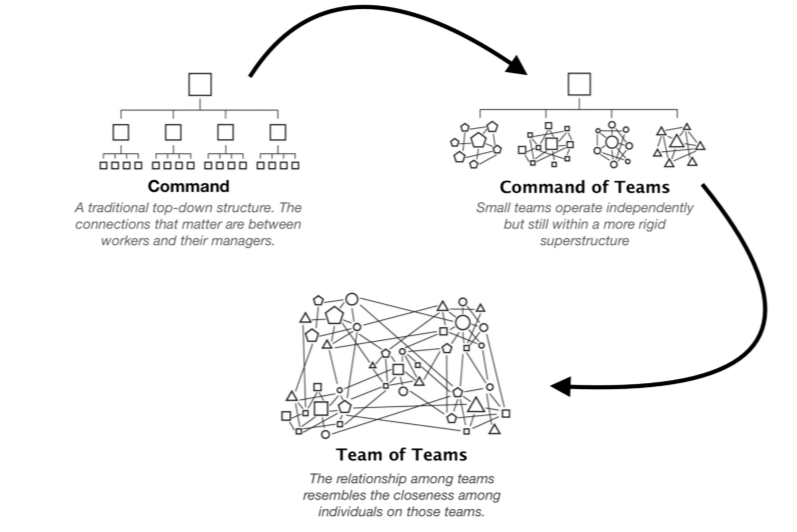We hope wherever you are in the world, this finds you well. Many of us have been separated physically from some of the most important people in our lives—friends, family, and even co-workers. We definitely miss seeing our respective teams face-to-face. Working in and with great teams with great people has been one of the most fulfilling aspects of our own careers in academia. Teams which are close, determined, resilient, and inspiring to be part of. Yet, the very things that make individual teams close—and even effective—can also make them ineffective when it matters most.
Our remarkable resource this month is “Team of Teams,” a book by the retired United States Army General Stanley McChrystal which has its origin in how the strengths of smaller teams composed of the most talented people becomes their weakness and, ultimate, failing. This happens particularly when members of highly cohesive close teams have to work with people from other teams in larger groups.

Image Source Above: McChrystal, S. (2015). Team of Teams: New Rules of Engagement for a Complex World. [p.129]
The strong team bonds which usually hold each team closely together as a cohesive high-performing team, tend to lead then to resistance, harshness, and poor communication with non-team members—particularly those seen to be from other teams. Drawing on his analysis of the US Armed forces, and the lessons from the lack of communication between the FBI and CIA prior to the Sept 11th terrorist attacks, McChrystal recounts his efforts to create team-of-teams to adapt better to the threats of terrorism. Highly cohesive larger teams which can navigate the step up from being smaller high-performing teams.
While those of us working in academic workplaces aren’t exposed to the same daily risks faced by McChrystal and his forces, we often see the negative effects of teams played out in poor relations, low communication, and hyper-criticism between teams working in the same building or department. Faculties or units at the same University come to see each other as rivals. Such teams lose sight of the bigger picture, and ultimately fail to realize the potential of not only being in a great team—but also a great team of teams.
Team of Teams by Stanley McChrystal
Key Messages
Bonds & Goals
Organizations and individuals seeking to work better in teams of teams should commit to building strong bonds outside of their normal team working.
Ongoing and comprehensive communication about the larger goals of the team of teams is key: what success is and who is going to do what to meet them is key.
Empowered to Execute
Teams of teams work best with decentralized decision-making—with most or all team members feeling empowered to act alone if and when necessary to further the larger team of teams goal. This cannot accommodate team leaders or members who want to be involved and make every big (and sometimes small!) decision. Team of teams working is about every member knowing their role and knowing the overall goals and daily state and progress of the team of teams. Ongoing and fully open communication with all team of teams members is vital, and can be done using today’s shared cloud-based technologies.
Command + Control
Teams of teams working cannot function well in conventional command and control management cultures or workplace. These control-based cultures are too slow to meet the challenges and problems of today’s world and workplaces. Team of teams approaches to collaborative work helps develop agile large teams that are fun to be part of, are more agile, and more effective at meeting their goals.
Key Applications
- Reflecting on your own academic workplace, where and how do you see the weaknesses of cohesive teams played out? Can you recall specific examples? How did team strengths transcend into larger weaknesses?
- Where do you see command-and-control approaches to teams in your work places? What do these practices reflect and what are possible consequences to the individual team members, any team leads, and team performance?
- To introduce a team of teams approach in your workplace—what would some first, easier, steps look like? How could you start to blur the lines between established teams more and encourage a team of teams approach?
